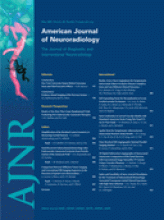Abstract
BACKGROUND AND PURPOSE: Animal models with appropriate volume are crucial for preclinical assessment of aneurysm therapies. Our purpose was to control the aneurysm volume by adjusting the position of ligation during creation of elastase-induced aneurysms in rabbits.
MATERIALS AND METHODS: Sixty elastase-induced aneurysms in rabbits were created. Two different methods were used for creation, including group 1 (n = 30) by using a lower ligation (from the origin of the right common carotid artery [RCCA] to the ligation point, 10 mm) and group 2 (n = 30) by using a higher ligation (from the origin of the RCCA to the ligation point, 15 mm). Aneurysm sizes (neck diameter, width, and height) and volumes in the 2 groups were measured and calculated, and they were compared by using the Student t test.
RESULTS: The mean aneurysm neck diameter, width, and height for group 2 were significantly larger than those of group 1 (3.3 ± 0.8 versus 2.7 ± 0.6 mm, P < .001; 3.7 ± 0.7 versus 2.5 ± 0.7 mm, P < .001; 9.0 ± 1.7 versus 7.3 ± 1.9 mm, P < .001, respectively). The aneurysm volume in group 2 was significantly larger than that in group 1 (102.4 ± 54.8 mm3 versus 36.6 ± 26.8 mm3, P < .001).
CONCLUSION: The aneurysm volume of elastase-induced models in rabbits can be controlled by adjusting the position of the ligation. Using a higher ligation can create relatively more voluminous aneurysms, compared with using a lower ligation.
- Copyright © American Society of Neuroradiology











